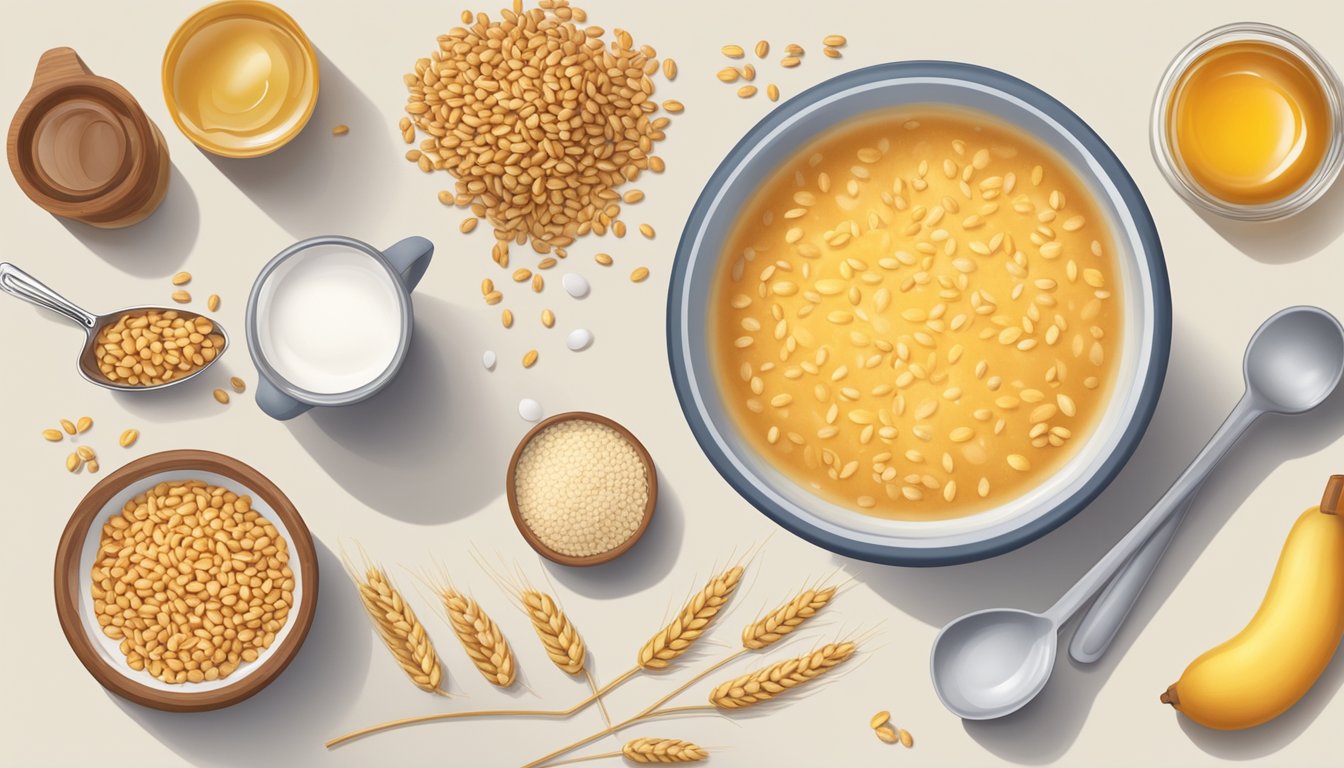Wheat berries are a nutritious whole grain that can transform your breakfast routine. These hearty kernels of wheat offer a delightful chewy texture and nutty flavor, making them an excellent base for wholesome morning meals. Cooking wheat berries is simple: combine one part wheat berries with three parts water, bring to a boil, then simmer for about an hour until tender.
Prepared wheat berries can be used to create nourishing grain bowls topped with fresh fruits, nuts, and a drizzle of honey. Their versatility allows for both sweet and savory applications, catering to diverse taste preferences. Wheat berries are rich in fiber, protein, and essential nutrients, providing sustained energy to fuel your day.
Incorporating wheat berries into your breakfast routine offers a departure from traditional cereals while maintaining the convenience of make-ahead meals. By preparing a batch at the beginning of the week, you can easily assemble quick and satisfying breakfasts on busy mornings. This wholesome grain is a valuable addition to any health-conscious diet.
The Nutritional Profile of Wheat Berries

Wheat berries are nutritional powerhouses, packed with essential macronutrients and fiber. They offer a balanced mix of carbohydrates and protein, making them an excellent choice for a wholesome breakfast.
Understanding Macronutrients
Wheat berries contain a well-rounded macronutrient profile. A quarter-cup (48g) serving provides approximately:
- 170 calories
- 32g carbohydrates
- 9g protein
- 1.5g fat
This composition makes wheat berries an energy-dense food, ideal for starting the day. The carbohydrates offer sustained energy, while the protein content supports muscle health and satiety.
The Role of Dietary Fiber
Wheat berries are rich in dietary fiber, a crucial component for digestive health. As whole grains, they retain the bran layer, which is the primary source of fiber.
Fiber aids in:
- Promoting regular bowel movements
- Maintaining gut health
- Controlling blood sugar levels
- Reducing cholesterol
A diet high in fiber from whole grains like wheat berries has been linked to a lower risk of heart disease and certain cancers.
Protein Content in Wheat Berries
The protein content in wheat berries is notable, especially for a plant-based source. With 9 grams of protein per quarter-cup serving, they contribute significantly to daily protein needs.
Wheat berry protein:
- Supports muscle growth and repair
- Helps maintain healthy skin, hair, and nails
- Plays a role in enzyme and hormone production
For vegetarians and vegans, wheat berries can be a valuable protein source. They contain all nine essential amino acids, making them a complete protein, though not as high-quality as animal sources.
Purchasing and Storing Wheat Berries
Wheat berries are versatile whole grains that can be stored long-term with proper techniques. Different varieties offer unique flavors and textures for breakfast dishes.
Different Types of Wheat Berries
Hard red winter wheat berries have a nutty flavor and chewy texture. They’re ideal for hearty breakfast porridges.
Soft white wheat berries are milder and work well in sweeter breakfast dishes.
Hard red spring wheat berries provide high protein content and a robust flavor profile.
Pearled wheat berries have the bran partially removed, resulting in a quicker cooking time.
Ancient grains like kamut, spelt, and farro are wheat berry relatives with distinct tastes and nutritional benefits.
Where to Buy Quality Grains
Health food stores often carry a selection of wheat berries and ancient grains in their bulk sections.
Online retailers specializing in whole grains offer a wide variety of options, including organic and non-GMO choices.
Local farms or farmers’ markets may sell freshly harvested wheat berries during certain seasons.
Some grocery store chains now stock wheat berries in their natural foods aisles or bulk departments.
Storage Tips for Freshness
Store wheat berries in airtight containers to protect against moisture and pests. Food-grade buckets or glass jars work well.
Keep containers in a cool, dry place away from direct sunlight. A pantry or basement is ideal.
For long-term storage, use oxygen absorbers in sealed Mylar bags to prevent spoilage.
Freezing wheat berries can extend their shelf life. Spread them on a baking sheet, freeze, then transfer to freezer-safe containers.
Properly stored wheat berries can last up to 20 years, making them an excellent addition to long-term food storage plans.
Preparation Basics Before Cooking

Properly preparing wheat berries before cooking is essential for achieving the best texture and flavor. These steps enhance the grains’ nutritional value and reduce cooking time.
The Importance of Soaking
Soaking wheat berries is a crucial step in the preparation process. Place the grains in a bowl and cover them with cool water. Let them soak for 8-12 hours or overnight. This process softens the tough outer layer of the berries, making them easier to cook and digest.
Soaking also activates enzymes within the grains, potentially increasing their nutritional value. For those short on time, a quick soak method can be used. Bring water to a boil, add the wheat berries, and let them sit for an hour before cooking.
Rinsing and Sorting
After soaking, thoroughly rinse the wheat berries under cool running water. This removes any dirt or debris that may be present. Use a fine-mesh strainer for this process to ensure no grains are lost.
Carefully inspect the berries and remove any that appear discolored or damaged. Look for small pebbles or other foreign objects that might have made their way into the package. This step ensures only the highest quality grains make it into your meal.
Toasting for Enhanced Flavor
Toasting wheat berries before cooking can significantly enhance their nutty flavor. Spread the rinsed and drained berries on a baking sheet in a single layer. Preheat the oven to 350°F (175°C).
Toast the berries for 10-15 minutes, stirring occasionally to ensure even browning. Keep a close eye on them to prevent burning. The toasted berries will have a deeper color and a more pronounced aroma.
This step is optional but can add depth to dishes like salads or breakfast bowls. Toasted wheat berries also work well in meal prep, as they maintain their enhanced flavor even after cooking and storing.
Cooking Methods for Wheat Berries
Wheat berries can be prepared using several techniques, each offering unique advantages. The cooking process typically involves simmering the grains until tender and chewy.
Stovetop Technique
To cook wheat berries on the stovetop, rinse 1 cup of grains and add them to a pot with 3 cups of water or broth. Bring the liquid to a boil, then reduce heat and simmer. Cover and cook for 45-60 minutes, stirring occasionally.
The grains are done when they’re tender but still chewy. Drain any excess liquid. For added flavor, toast the wheat berries in a dry pan before cooking.
Season cooked wheat berries with salt, herbs, or spices to taste. They can be served hot as a side dish or cooled for use in salads.
Using a Pressure Cooker
Pressure cooking significantly reduces the cooking time for wheat berries. Combine 1 cup of rinsed wheat berries with 3 cups of water in the Instant Pot or pressure cooker.
Set the cooker to high pressure for 30 minutes. Allow for natural pressure release, which takes about 10-15 minutes.
Drain any excess water. The result is perfectly cooked wheat berries with a tender yet chewy texture. This method is ideal for busy mornings or meal prep.
The Benefits of a Slow Cooker
For a hands-off approach, the slow cooker is an excellent option. Add 1 cup of rinsed wheat berries and 3 cups of water to the slow cooker.
Set it on low for 8 hours or high for 4 hours. This method is perfect for overnight cooking, ensuring a warm breakfast is ready in the morning.
The slow cooker produces evenly cooked, tender wheat berries. It’s particularly useful for making larger batches. Add dried fruit, nuts, or spices before cooking for enhanced flavor.
Adding Flavor and Texture

Elevating wheat berries from simple to extraordinary involves incorporating a variety of flavors and textures. The right combination of spices, nuts, fruits, and other add-ins can transform this nutritious grain into a delightful breakfast experience.
Choosing the Right Spices
Spices play a crucial role in enhancing the taste of wheat berries. Cinnamon and nutmeg are classic choices that add warmth and depth. A pinch of cinnamon can impart a subtle sweetness, while nutmeg offers a slightly nutty flavor.
For a unique twist, try fennel seeds. They bring a mild licorice-like taste that complements the nuttiness of wheat berries. Rose water is another intriguing option, adding a delicate floral note to the dish.
Experiment with different spice combinations to find your perfect blend. Start with small amounts and adjust to taste.
Incorporating Nuts and Dried Fruit
Adding nuts and dried fruit to wheat berries creates a satisfying contrast in texture and flavor. Almonds, hazelnuts, and walnuts provide a pleasant crunch and boost the nutritional value with healthy fats and protein.
Raisins are a popular choice for their natural sweetness and chewy texture. Other dried fruits like chopped apricots, cranberries, or figs can add variety and interest to your breakfast bowl.
For best results, toast nuts lightly before adding them to enhance their flavor. Soak dried fruit briefly in warm water to plump them up if desired.
Exploring Sweet and Savory Add-Ins
Wheat berries are versatile and can be adapted for both sweet and savory preferences. For a sweet breakfast, drizzle honey or maple syrup over the cooked berries. A dollop of yogurt adds creaminess and a tangy contrast.
On the savory side, try mixing in a splash of soy sauce for umami flavor. Chopped scallions can provide a fresh, oniony bite that complements the hearty wheat berries.
For a balanced meal, combine sweet and savory elements. A bowl of wheat berries with yogurt, honey, and a sprinkle of toasted nuts offers a satisfying mix of flavors and textures.
Serving Suggestions for Breakfast Wheat Berries
Wheat berries offer a versatile foundation for delicious and nutritious breakfast options. Their hearty texture and nutty flavor complement a wide range of ingredients, allowing for both sweet and savory combinations.
Classic Wheat Berry Breakfast Bowl
Start your day with a wholesome wheat berry breakfast bowl. Combine cooked wheat berries with a splash of warm milk or plant-based alternative. Add a drizzle of honey or maple syrup for sweetness.
Top with sliced bananas, berries, or diced apples for freshness. Sprinkle chopped nuts or seeds for extra crunch and protein. A dash of cinnamon or nutmeg enhances the flavors.
For added nutrition, stir in a spoonful of chia seeds or ground flaxseed. This classic bowl provides a satisfying balance of complex carbohydrates, fiber, and essential nutrients.
Refreshing Grain Salads
Transform wheat berries into refreshing breakfast salads. Mix cooled wheat berries with chopped fresh fruits like strawberries, peaches, or mangoes.
Add a handful of leafy greens such as baby spinach or arugula for a nutrient boost. Toss in some crumbled feta or goat cheese for a tangy contrast.
Dress the salad with a light vinaigrette made from lemon juice, olive oil, and honey. Garnish with mint leaves or basil for a bright, herbaceous note.
For extra crunch and visual appeal, sprinkle pomegranate seeds or toasted pumpkin seeds on top. This refreshing option works well for warmer mornings or as a brunch dish.
Combinations with Yogurt and Creamy Textures
Create a creamy wheat berry parfait by layering cooked and cooled wheat berries with Greek yogurt. This combination offers a protein-rich start to the day.
Swirl in fruit compotes or fruit purees for natural sweetness and vibrant color. Alternate layers of wheat berries, yogurt, and fruits in a glass for an attractive presentation.
For added indulgence, drizzle with a touch of honey or maple syrup. Sprinkle granola or toasted coconut flakes on top for a delightful crunch.
This creamy option can be prepared in advance and stored in the refrigerator, making it a convenient grab-and-go breakfast for busy mornings.
Recipe Ideas and Variations
Wheat berries offer a versatile base for both sweet and savory breakfast options. Their nutty flavor and chewy texture can be enhanced with various ingredients and cooking methods.
Sweet Morning Delights
Add ground cinnamon and a sweetener like honey or maple syrup to cooked wheat berries for a simple yet delicious breakfast. Mix in diced apples, raisins, or dried cranberries for extra flavor and nutrition.
For a creamy treat, combine wheat berries with Greek yogurt and top with fresh berries and a drizzle of agave nectar. This protein-packed meal will keep you satisfied until lunch.
Try a wheat berry breakfast pudding by simmering the grains in milk with vanilla extract and a pinch of salt. Once cooked, stir in cocoa powder and your favorite nuts for a chocolatey morning indulgence.
Savory Breakfast Options
Transform wheat berries into a hearty breakfast bowl by adding sautéed vegetables like spinach, mushrooms, and bell peppers. Top with a poached egg and sprinkle with feta cheese for a Mediterranean-inspired dish.
Create a breakfast “fried rice” by stir-frying cooked wheat berries with diced onions, garlic, and your choice of protein such as tofu or chicken. Season with soy sauce and sesame oil for an Asian-inspired morning meal.
For a twist on traditional oatmeal, cook wheat berries with vegetable broth and stir in nutritional yeast for a cheesy flavor. Add roasted cherry tomatoes and fresh herbs for a savory start to your day.
Creative Grain-Based Dishes
Incorporate wheat berries into soups and stews for added texture and nutrition. They work well in vegetable-based soups or heartier meat stews, absorbing flavors while maintaining their pleasant chewiness.
Use wheat berries as a base for grain salads. Combine them with roasted vegetables, nuts, and a tangy vinaigrette for a refreshing cold dish that can be prepared in advance for quick breakfasts throughout the week.
Blend cooked wheat berries into pancake or waffle batter for a fiber-rich breakfast twist. The grains add a delightful crunch and nutty flavor to these classic morning treats.
Conclusion
Wheat berries offer a versatile and nutritious option for breakfast. Their chewy texture and nutty flavor provide a satisfying alternative to traditional morning grains.
Meal prep enthusiasts will appreciate wheat berries’ ability to be cooked in advance. A large batch can be prepared and stored in the refrigerator for quick, convenient meals throughout the week.
This nutritious whole grain packs a powerful punch of fiber, protein, and essential nutrients. It keeps you feeling full and energized for hours, making it an excellent choice for busy mornings.
Experiment with different toppings and flavor combinations to keep your wheat berry breakfasts exciting. Sweet or savory, the possibilities are endless.
With proper storage, wheat berries can last for years, making them a smart addition to any pantry. Their long shelf life and nutritional density make them a valuable staple for health-conscious individuals.
Incorporating wheat berries into your breakfast routine can diversify your diet and introduce new textures and flavors. This ancient grain offers modern appeal for those seeking wholesome, nutrient-rich meals to start their day.




